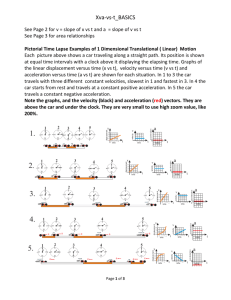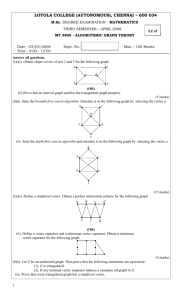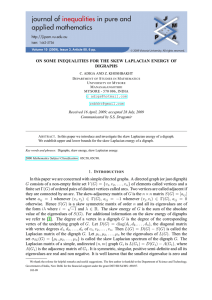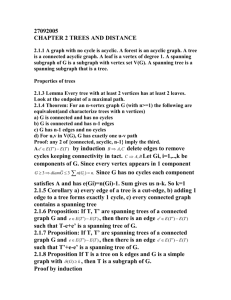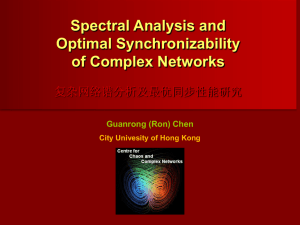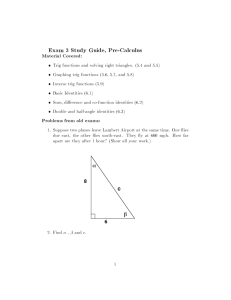ON THE APPROXIMATION OF LAPLACIAN EIGENVALUES IN GRAPH DISAGGREGATION
advertisement
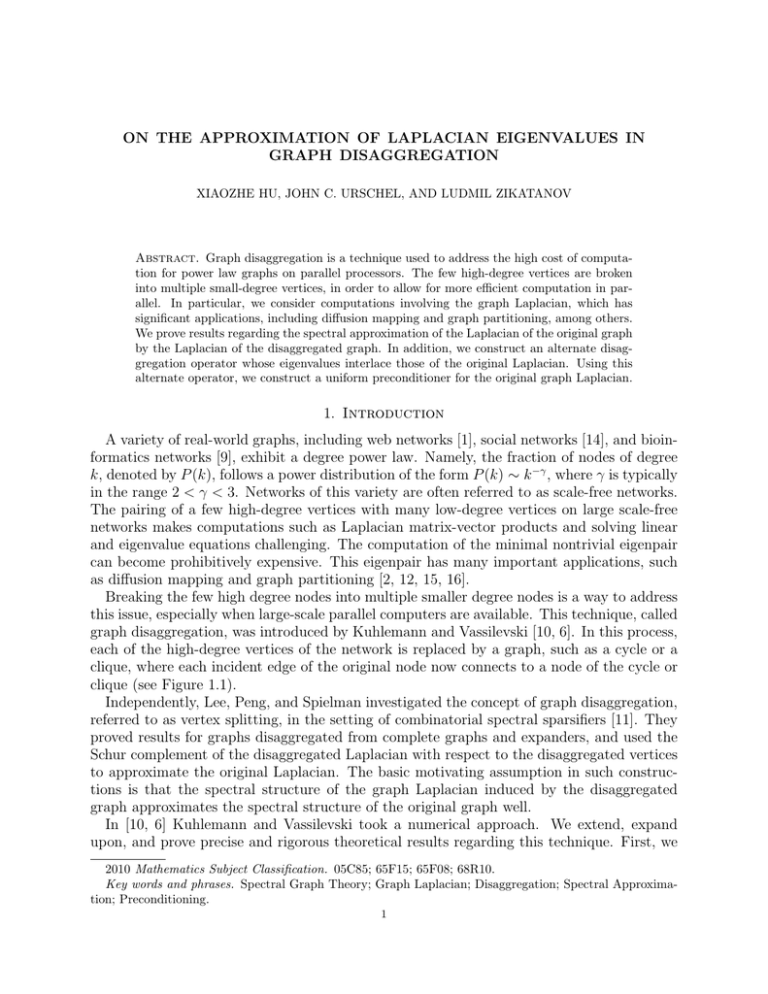
ON THE APPROXIMATION OF LAPLACIAN EIGENVALUES IN
GRAPH DISAGGREGATION
XIAOZHE HU, JOHN C. URSCHEL, AND LUDMIL ZIKATANOV
Abstract. Graph disaggregation is a technique used to address the high cost of computation for power law graphs on parallel processors. The few high-degree vertices are broken
into multiple small-degree vertices, in order to allow for more efficient computation in parallel. In particular, we consider computations involving the graph Laplacian, which has
significant applications, including diffusion mapping and graph partitioning, among others.
We prove results regarding the spectral approximation of the Laplacian of the original graph
by the Laplacian of the disaggregated graph. In addition, we construct an alternate disaggregation operator whose eigenvalues interlace those of the original Laplacian. Using this
alternate operator, we construct a uniform preconditioner for the original graph Laplacian.
1. Introduction
A variety of real-world graphs, including web networks [1], social networks [14], and bioinformatics networks [9], exhibit a degree power law. Namely, the fraction of nodes of degree
k, denoted by P (k), follows a power distribution of the form P (k) ∼ k −γ , where γ is typically
in the range 2 < γ < 3. Networks of this variety are often referred to as scale-free networks.
The pairing of a few high-degree vertices with many low-degree vertices on large scale-free
networks makes computations such as Laplacian matrix-vector products and solving linear
and eigenvalue equations challenging. The computation of the minimal nontrivial eigenpair
can become prohibitively expensive. This eigenpair has many important applications, such
as diffusion mapping and graph partitioning [2, 12, 15, 16].
Breaking the few high degree nodes into multiple smaller degree nodes is a way to address
this issue, especially when large-scale parallel computers are available. This technique, called
graph disaggregation, was introduced by Kuhlemann and Vassilevski [10, 6]. In this process,
each of the high-degree vertices of the network is replaced by a graph, such as a cycle or a
clique, where each incident edge of the original node now connects to a node of the cycle or
clique (see Figure 1.1).
Independently, Lee, Peng, and Spielman investigated the concept of graph disaggregation,
referred to as vertex splitting, in the setting of combinatorial spectral sparsifiers [11]. They
proved results for graphs disaggregated from complete graphs and expanders, and used the
Schur complement of the disaggregated Laplacian with respect to the disaggregated vertices
to approximate the original Laplacian. The basic motivating assumption in such constructions is that the spectral structure of the graph Laplacian induced by the disaggregated
graph approximates the spectral structure of the original graph well.
In [10, 6] Kuhlemann and Vassilevski took a numerical approach. We extend, expand
upon, and prove precise and rigorous theoretical results regarding this technique. First, we
2010 Mathematics Subject Classification. 05C85; 65F15; 65F08; 68R10.
Key words and phrases. Spectral Graph Theory; Graph Laplacian; Disaggregation; Spectral Approximation; Preconditioning.
1
2
XIAOZHE HU, JOHN C. URSCHEL, AND LUDMIL ZIKATANOV
Figure 1.1. Example of disaggregation: original graph (left); disaggregate
using cycle (middle); disaggregate using clique (right).
look at the case of a single disaggregated vertex and establish bounds on the error in spectral
approximation with respect to the Laplacians of the original and disaggregated graph, as well
as results related to the Cheeger constant. We investigate a conjecture made in [10] and give
strong theoretical evidence that it does not hold in general. Then, we treat the more general
case of disaggregation of multiple vertices and prove analogous results. Finally, we construct
an alternative disaggregation operator whose eigenvalues interlace with those of the original
graph Laplacian, and, hence, provide excellent approximation to the spectrum of the latter.
We then use this new disaggregation operator to construct a uniform preconditioner for the
graph Laplacian of the original graph. We prove that the preconditioned graph Laplacian
can be made arbitrarily close to the identity operator if we require that the weights of the
internal disaggregated edges are sufficiently large.
2. Single Vertex Disaggregation
Consider a weighted, connected, undirected graph G = (V, E, ω), |V | = n. Let e = (i, j)
denote an edge that connects vertices i and j, and h·, ·i and k · k denote the standard `2 -inner
product and the corresponding induced norm. The associated weighted graph Laplacian
A ∈ Rn×n is given by
X
hAu, vi =
ωe (ui − uj )(vi − vj ), ωe = (−aij ),
e=(i,j)∈E
where we denote the (i, j)-th element of A by aij . Without loss of generality, let us disaggregate the last vertex vn of the graph G. Then, the Laplacian can be written in the following
block form
A0 −an
A=
,
−aTn ann
where ann is the degree of vn . Here, we assume that the graph is simply connected and the
associated Laplacian A has eigenvalues
0 = λ1 (A) < λ2 (A) ≤ · · · ≤ λn (A)
and corresponding eigenvectors
1n = ϕ(1) (A), ϕ(2) (A), · · · , ϕ(n) (A),
where 1n = (1, · · · , 1)T .
| {z }
n
The eigenpair λ2 (A), ϕ(2) (A) has special significance, and therefore λ2 (A) is referred to as
the algebraic connectivity, denoted a(G), and ϕ(2) (A) is referred to as the Fiedler vector.
ON THE APPROXIMATION OF LAPLACIAN EIGENVALUES IN GRAPH DISAGGREGATION
3
We can also write a given nontrivial eigenpair (λ(A), ϕ(A)), λ(A) 6= 0, kϕ(A)k = 1, in
block notation, namely
ϕ0
ϕ(A) =
.
ϕn
We have the relations
hϕ0 , 1n0 i + ϕn = 0,
A0 ϕ0 − ϕn an = λ(A)ϕ0 ,
ann ϕn − aTn ϕ0 = λ(A)ϕn ,
where n0 = n − 1. Suppose that the vertex vn is disaggregated into d vertices, with an
unspecified connected structure between the disaggregated elements. We will denote this
graph by GD . This induces a disaggregated graph Laplacian AD ∈ RN ×N , N = n0 + d,
with eigenvalues 0 = λ1 (AD ) < λ2 (AD ) ≤ · · · ≤ λN (AD ) and corresponding eigenvectors
1N = ϕ(1) (AD ), ϕ(2) (AD ), · · · , ϕ(N ) (AD ). We can write AD in block form
A0 −A0n
.
AD =
−AT0n An
We have the relations
ann = aTn 1n0 ,
AT0n 1n0 = An 1d ,
an = A0 1n0 = A0n 1d .
Let us introduce the prolongation operator P : Rn → RN ,
In0 ×n0 0
(2.1)
P =
.
0
1d
The following result is immediate.
Lemma 1. Let A and AD be the graph Laplacian of the original graph G and the disaggregated
and simply connected graph GD , respectively. If P is defined as (2.1), then we have
A = P T AD P.
We aim to show that the algebraic connectivity of AD is bounded away from the algebraic
connectivity of the original graph A. To do so, suppose we have an eigenpair (λ, ϕ) of the
Laplacian of the original graph G. We prolongate the eigenvector ϕ to the disaggregated
graph GD and obtain an approximate eigenvector by the procedure
d−1
ϕ0
e = P ϕ − s1N =
(2.2)
ϕ
− s1N , where s =
ϕn .
ϕ n 1d
N
e 1N i = 0.
This gives hϕ,
e to be an approximation of ϕ on the non-trivial eigenspace of the disaggreWe consider ϕ
gated operator AD . We have the following relation between the eigenvalue λ of A and the
e with respect to AD .
Rayleigh quotient of ϕ
4
XIAOZHE HU, JOHN C. URSCHEL, AND LUDMIL ZIKATANOV
Lemma 2. Let (λ, ϕ), kϕk = 1, be an eigenpair of the graph Laplacian A associated with a
e be defined by (2.2). We have
simply connected graph G, and ϕ
e :=
RQ(ϕ)
e ϕi
e
hAD ϕ,
λ
=
.
(d−1)n
e ϕi
e
hϕ,
1 + N ϕ2n
Proof. We have
e ϕi
e = hP ϕ − s1N , P ϕ − s1N i = hP ϕ, P ϕi − 2shP ϕ, 1N i + s2 h1N , 1N i
hϕ,
= hϕ0 , ϕ0 i + ϕ2n h1d , 1d i − 2s (hϕ0 , 1n0 i + ϕn h1d , 1d i) + s2 N
= hϕ0 , ϕ0 i + ϕ2n + (d − 1)ϕ2n − 2s(d − 1)ϕn + s2 N
(d − 1)2 (d − 1)2 2
= 1 + (d − 1) − 2
+
ϕn
N
N
(d − 1)n 2
=1+
ϕn
N
and
e ϕi
e = hAD (P ϕ − s1N ), P ϕ − s1N i
hAD ϕ,
= hAD P ϕ, P ϕi − 2shAD 1N , P ϕi + s2 hAD 1N , 1N i
= hP T AD P ϕ, ϕi = hAϕ, ϕi = λ.
This completes the proof.
The following result quickly follows by applying Lemma 2 to the Fielder vector.
Theorem 1. Let ϕ = (ϕ0 , ϕn )T , kϕk = 1, be the Fiedler vector of the graph Laplacian A
associated with a simply connected graph G. Let AD be the graph Laplacian corresponding
to the disaggregated and simply connected graph GD resulting from disaggregating one vertex
into d > 1 vertices. We have
a(G)
(d − 1)n 2
≥1+
ϕn .
a(GD )
N
e is orthogonal to 1N , we have
Proof. Noting that ϕ
a(GD ) ≤
which completes the proof.
e ϕi
e
hAD ϕ,
λ
a(G)
=
,
=
(d−1)n
2
e ϕi
e
hϕ,
1 + N ϕ2n
1 + (d−1)n
ϕ
n
N
If the characteristic value of the disaggregated vertex is non-zero, then the algebraic connectivity of the disaggregated graph stays bounded away from that of the original graph,
independent of the structure of An . Therefore, as the weight on the internal edges approaches
infinity, the approximation stays bounded away.
In [10], the authors made the following conjecture.
Conjecture 1. Under certain conditions the Laplacian eigenvalues of the graph Laplacian
of the disaggregated graph approximate the eigenvalues of the graph Laplacian of the original
graph, provided that the weight on the internal edges of the disaggregation is chosen to be
large enough.
ON THE APPROXIMATION OF LAPLACIAN EIGENVALUES IN GRAPH DISAGGREGATION
5
Theorem 1 directly implies that Conjecture 1 is false when the characteristic value of
the disaggregated vertex is non-zero, which, for a random power law graph, occurs with
probability one.
We also have the following result, providing an estimate of how close the approximation
e is to the invariant subspace with respect to AD .
ϕ
Lemma 3. Let A and AD be the original graph and disaggregated graph, (λ, ϕ) be an eigene be defined
pair of the graph Laplacian A associated with a simply connected graph G, and ϕ
by (2.2). We have
!
p
dn(d
+
n)
dn
e − RQ(ϕ)
e ϕk
e ≤ kAT0n (1n0 − ϕ0 /ϕn )k +
kAD ϕ
λ+
λ|ϕn | |ϕn |.
N
N
Proof. We recall that
e =
kϕk
(d − 1)n 2
1+
ϕn
N
and
e =
|λ − RQ(ϕ)|
1
1/2
(d−1)n 2
ϕn
N
λ.
2
+ (d−1)n
ϕ
n
N
We also have
A0 ϕ0 − ϕn an
A0 ϕ0 − ϕn A0n 1d
e = AD (P ϕ − s1N ) = AD P ϕ =
=
AD ϕ
AT0n (ϕn 1n0 − ϕ0 )
ϕn An 1d − AT0n ϕ0
0
0
e + sλ1N +
= λP ϕ +
= λϕ
AT0n (ϕn 1n0 − ϕ0 ) − λϕn 1d
AT0n (ϕn 1n0 − ϕ0 ) − λϕn 1d
λϕn
0
10
0
e+
= λϕ
(d − 1)
−n
+
,
0
1d
AT0n (ϕn 1n0 − ϕ0 )
N
giving
e − RQ(ϕ)
e ϕk
e ≤ kAD ϕ
e − λϕk
e + |λ − RQ(ϕ)|k
e ϕk
e
kAD ϕ
p
(d−1)n
(d − 1)2 n0 + dn2
N
|ϕn |λ + q
≤ kAT0n (ϕn 1n0 − ϕ0 )k +
ϕ2n λ
N
1 + (d−1)n
ϕ2n
N
!
p
dn(d
+
n)
dn
≤ kAT0n (1n0 − ϕ0 /ϕn )k +
λ+
λ|ϕn | |ϕn |.
N
N
In many applications, we are only concerned with minimal Laplacian eigenpairs. For
minimal eigenvalues of scale-free graphs, we have λ = O(1) and ϕn = O(N −1/2 ). In this
way, often the largest source of error comes from the term kAT0n (ϕn 1n0 − ϕ0 )k. Heuristically,
the error of this term is typically best controlled when d is relatively small and each new
disaggregate is connected to roughly the same number of exterior vertices.
Next, we consider the eigenvalues of the normalized Laplacian. This gives us insight into
how the Cheeger constant changes after disaggregating a vertex. Again, suppose we have an
eigenpair (ν, φ) of the normalized graph Laplacian D−1 A, where D is the degree matrix of
G, namely D = diag(a11 , a22 , · · · , ann ). Again, we prolongate the eigenvector φ and obtain
6
XIAOZHE HU, JOHN C. URSCHEL, AND LUDMIL ZIKATANOV
−1
an approximate eigenvector of the disaggregated normalized graph Laplacian DD
AD , where
DD is the degree matrix of GD , in a similar fashion
e = P φ − s1N ,
φ
(2.3)
where s =
hP φ, 1N iDD
.
h1N , 1N iDD
We may write DD in the following way
D
D
D
D
DD = diag(aD
1,1 , · · · , an0 ,n0 , an,n , an+1,n+1 , · · · , aN,N )
D
ex ex
ex
= diag(aD
1,1 , · · · , an0 ,n0 , ωn , ωn+1 , · · · , ωN ) + diag(0, · · · , 0, dn , dn+1 , · · · , dN )
ex
1
,
+ DD
=: DD
where ωn , ωn+1
of the edges incident with vertex vn on the original
P,N· · · ωN are the weights
ex
graph (note i=n ωi = an,n ) and di = aD
i,i − ωi , i = n, n + 1, · · · , N . We may also rewrite
the shift s as
PN ex
hP φ, 1N iDD
i=n di φn
s=
.
= P
N
D
h1N , 1N iDD
i=1 ai,i
Let ωtotal (H) denote the total weights of a graph H, and let Ga be the disaggregated
e as an approximation of the eigenvectors of the
local subgraph. Similarly, we consider φ
disaggregated normalized graph Laplacian. We have the following lemma.
Theorem 2. Let (ν, φ) be an eigenpair of the normalized graph Laplacian associated with a
e be defined by (2.3). We have
simply connected graph G and φ
e φi
e
hAD φ,
=
e φi
e
1+
hDD φ,
(2.4)
ν
2ωtotal (G) ωtotal (Ga ) 2
φn
ωtotal (GD )
,
and
ν2D
(2.5)
= αν2 ,
α=
2ωtotal (G) ωtotal (Ga ) 2
φn
1+
ωtotal (GD )
−1
≤ 1.
Proof. We have
e φi
e = hAD (P φ − s1N ), P φ − s1N i = hAD P φ, φi = hAφ, φi = ν
hAD φ,
and
hDD φ, φi = hDD P φ, P φi − shDD 1N , P φi
1
ex
= hDD
P φ, P φi + hDD
P φ, P φi − shDD 1N , P φi
P
2
N
ex
N
d
φ
X
n
i=n i
2
= hDφ, φi +
dex
PN D
i φn −
i ai,i
i=n
P
P
P
N D
N
N
ex
ex
i ai,i −
i=n di
i=n di
=1+
φ2n
PN D
i ai,i
Pn
PN ex ( i=1 ai,i )
i=n di
=1+
φ2n .
PN D
a
i=1 i,i
ON THE APPROXIMATION OF LAPLACIAN EIGENVALUES IN GRAPH DISAGGREGATION
7
PN ex
P
PN D
Noting that N
i=n di = 2ωtotal (Ga ), we
i=1 ai,i = 2ωtotal (G),
i=1 ai,i = 2ωtotal (GD ), and
obtain (2.4). Moreover, (2.5) follows directly from (2.4).
The Cheeger constant of a weighted graph is defined as follows [8, 4]
h(G) = min
∅6=U ⊂V
|E(U, Ū )|
,
min(vol(U ), vol(Ū ))
where
Ū = V \U,
vol(U ) =
X
δi ,
δi =
i∈U
X
ωe ,
|E(U, Ū )| =
e=(i,j)∈E
X
ωe .
e=(i,j)∈E
i∈U,j∈Ū
Due to the Cheeger inequality [8, 4], the Cheeger constant h(G) and ν2 are related as follows
p
(2.6)
1 − 1 − h(G)2 ≤ ν2 ≤ 2h(G).
Theorem 3. For the Cheeger constant of the original graph G and the disaggregated and
simply connected graph GD , we have
p
h(GD ) ≤ 1 − (1 − 2αh(G))2 ,
where α is defined by (2.5). If h(G) ≥
4α
,
4α2 +1
then h(GD ) ≤ h(G).
Proof. Based on (2.6) and (2.5), we have
q
p
p
h(GD ) ≤ 1 − (1 − ν2D )2 = 1 − (1 − αν2 )2 ≤ 1 − (1 − 2αh(G))2 .
Basic algebra shows that h(GD ) ≤ h(G) if h(G) ≥
4α
.
4α2 +1
3. Graph Disaggregation
We now move on to the more general case of multiple disaggregated vertices. Without
loss of generality, for a graph Laplacian A ∈ Rn×n , suppose we are disaggregating the first
m vertices. This gives us the disaggregated Laplacian AD ∈ RN ×N . Here, N is the number
of vertices in the disaggregated graph, given by
N =n−m+
m
X
dk = n − m + nd ,
k=1
nd =
m
X
dk .
k=1
Note that we have m groups of vertices associated with the disaggregation, which we can
also number consecutively
(3.1)
{1, . . . , N } = {1, . . . , d1 , . . . d1 + 1, . . . , d1 + d2 , . . . , nd + 1, . . . , N }.
| {z }
|
{z
}
d1
d2
Similar to the case of a single disaggregated vertex, we can establish a relationship between
A and AD through a prolongation matrix P : Rn → RN , given by
Pm
0
, where n0 = (n − m).
(3.2)
P =
0 In0 ×n0
8
XIAOZHE HU, JOHN C. URSCHEL, AND LUDMIL ZIKATANOV
Here, Pm ∈ Rnd ×m , and
1d1 0 . . . 0
0 1d2 . . . 0
Pm =
.
..
..
..
...
.
.
.
0
0 . . . 1dm
Note that PmT Pm = diag(d1 , . . . dm ). We have the following lemma, which can be easily
verified by simple algebraic calculation.
Lemma 4. Let A and AD be the graph Laplacian of the original graph G and the disaggregated
and simply connected graph GD , respectively. If P is defined as (3.2), then we have
A = P T AD P.
(3.3)
If we look at the disaggregated graph Laplacian AD directly, we can obtain a similar bound
on the algebraic connectivity as shown in Theorem 1. Let (λ, ϕ) be an eigenpair of A. We
can define an approximated eigenvector of AD by prolongating ϕ as follows
e = P ϕ − s1N ,
ϕ
(3.4)
m
1 X
where s =
(di − 1)ϕi .
N i=1
e 1N i = 0. Now we have the following lemma about the Rayleigh
It is easy to check that hϕ,
e with respect to AD .
quotient of ϕ
Lemma 5. Let (λ, ϕ) be an eigenpair of the graph Laplacian A associated with a simply
e be defined by (3.4). We have
connected graph G and ϕ
e :=
RQ(ϕ)
e ϕi
e
hAD ϕ,
≤
e ϕi
e
hϕ,
1+
1
N
λ
.
2
i=1 (di − 1)(n + nd − mdi )ϕi
Pm
e < λ.
Moreover, if for dmax
= maxi di , we have n + nd − mdmax
> 0, then RQ(ϕ)
i
i
Proof. We note that
e ϕi
e = hAD (P ϕ − s1N ), P ϕ − s1N i = hAD P ϕ, P ϕi − 2shAD 1N , P ϕi + s2 hAD 1N , 1N i
hAD ϕ,
= hP T AD P ϕ, ϕi = hAϕ, ϕi = λ.
ON THE APPROXIMATION OF LAPLACIAN EIGENVALUES IN GRAPH DISAGGREGATION
9
Denoting ϕ by ϕ = (ϕ1 , ϕ2 , · · · , ϕm , ϕ0 )T , we have
e ϕi
e = hP ϕ − s1N , P ϕ − s1N i = hP ϕ, P ϕi − 2shP ϕ, 1N i + s2 h1N , 1N i
hϕ,
!
m
m
X
X
2
= hϕ0 , ϕ0 i +
ϕi h1di , 1di i − 2s hϕ0 , 1n0 i +
ϕi h1di , 1di i + s2 N
= hϕ0 , ϕ0 i +
i=1
m
X
i=1
ϕ2i +
i=1
=1+
(di − 1)ϕ2i −
i=1
≥1+
=1+
i=1
m
X
(di − 1)ϕ2i −
(di − 1)
i=1
=1+
(di − 1)ϕ2i − 2s
i=1
m
X
m
X
m
X
1
N
(di − 1)ϕi + s2 N
i=1
m
X
!2
(di − 1)ϕi
i=1
m
mX
N
m
X
(di − 1)2 ϕ2i
i=1
N − m(di − 1) 2
ϕi
N
m
1 X
(di − 1)(n + nd − mdi )ϕ2i .
N i=1
This completes the proof.
From the Rayleigh quotient and applying the above lemma to the Fielder vector, we have
the following theorem concerning the algebraic connectivity.
Theorem 4. Let ϕ be the Fiedler vector of the graph Laplacian A associated with a simply
connected graph G and AD be the graph Laplacian corresponding to the disaggregated and
simply connected graph GD . Suppose we have disaggregated m vertices and each of those
vertices are disaggregated into di > 1 vertices, i = 1, 2, · · · , m. We have
m
1 X
a(G)
≥1+
(di − 1)(n + nd − mdi )ϕ2i .
a(GD )
N i=1
Proof. The proof is similar to the proof of Theorem 1 and uses Lemma 5.
It is possible to perform a more careful estimate, using the fact that disaggregating m
vertices at once is equivalent to disaggregating m vertices onePby one. Denote n0 = n and
ni = ni−1 − 1 + di , i = 1, 2, · · · , m. Note that ni = n − i + ik=1 dk , i = 1, 2, · · · , m and
N = nm . Recursively applying Theorem 1, we have the following result.
Theorem 5. Let ϕ be the Fiedler vector of the graph Laplacian A associated with a simply
connected graph G and AD be the graph Laplacian corresponding to the disaggregated and
simply connected graph GD , respectively. Suppose we disaggregated m vertices and each of
those are disaggregated into di > 1 vertices, i = 1, 2, · · · , m. We have
Y
a(G)
(di − 1)ni−1 2
≥
1+
ϕi .
a(GD )
ni
10
XIAOZHE HU, JOHN C. URSCHEL, AND LUDMIL ZIKATANOV
Proof. Let GiD be the resulting graph after disaggregating the i-th vertex in the graph Gi−1
D
and note that GD = Gm
D . We have
a(G)
a(G)
a(G1D )
a(Gm−1
D )
=
×
×
·
·
·
×
.
1
2
a(GD )
a(GD ) a(GD )
a(Gm
D)
The result follows immediately from applying Theorem 1 on each pair of graphs GiD and
Gi+1
D .
Remark 1. A direct consequence of Theorem 5 is a(GD ) ≤ a(G).
Similarly, we also have the following result concerning the minimal eigenvalue of the normalized graph Laplacian after disaggregating several vertices. Denote G0D = G, and denote
the graph after disaggregating vertex i by GiD . Note that Gm
D = GD . The local subgraph
corresponding to disaggregating vertex i is denoted by Gia .
Theorem 6. Let ν2 be the second smallest eigenvalue of the normalized graph Laplacian
associated with a simply connected graph G and ν2D be the second smallest eigenvalue of the
normalized graph Laplacian corresponding to the disaggregated and simply connected graph
GD . Suppose we disaggregated m vertices and each of them are disaggregated into di > 1
vertices, i = 1, 2, · · · , m. We have
m i−1
Y
2ωtotal (GD
ν2
) ωtotal (Gia ) 2
≥
1+
φi .
i
ω
(G
)
ν2D
total
D
i=1
Consequently, we have ν2D = αν2 , where
"m #−1
i
Y
2ωtotal (Gi−1
)ω
(G
)
total
a
D
φ2i
≤ 1.
(3.5)
α :=
1+
i
ω
(G
)
total
D
i=1
Proof. The result follows by applying Theorem 2 recursively.
Based on the estimates on the eigenvalues of normalized graph Laplacian, we can estimate
the Cheeger constants as follows.
Theorem 7. For the Cheeger constant of the original graph G and the disaggregated and
simply connected graph GD , we have
p
h(GD ) ≤ 1 − (1 − 2αh(G))2 ,
where α is defined by (3.5). If h(G) ≥
4α
,
4α2 +1
then h(GD ) ≤ h(G).
Proof. The proof is the same as the proof of Theorem 3.
4. Preconditioning Using Disaggregated Graph
We aim to show eigenvalue interlacing between A and a new operator, which is obtained
by scaling AD appropriately.
We can rescale P by introducing Pe = Ds P , where
−1/2
−1/2
Id1 ×d1 , . . . , dm
Idm ×dm , In0×n0 )
is a diagonal scaling matrix, giving us PeT Pe = I. Based on the scaled prolongation, we are
able to show the eigenvalues of diagonal scaled matrix
eD := D−1 AD D−1
(4.2)
A
(4.1)
Ds = diag(d1
s
s
ON THE APPROXIMATION OF LAPLACIAN EIGENVALUES IN GRAPH DISAGGREGATION
11
interlaces with A. First, let us recall the interlacing theorem.
Theorem 8 (Interlacing Theorem [5], Vol. 1, Chap. I). Let S ∈ RN ×n be such that S T S =
In×n , n < N and let B ∈ RN ×N be symmetric, with eigenvalues λ1 ≤ λ2 ≤ ... ≤ λn . Define
A = S T BS and let A have eigenvalues µ1 ≤ µ2 ≤ ... ≤ µm . Then λi ≤ µi ≤ λn−m+i .
From here, we have the following.
eD = D−1 AD D−1
Theorem 9. Let A have eigenvalues λ1 (A) ≤ λ2 (A) ≤ ... ≤ λn (A) and A
s
s
eD ) ≤ λ2 (A
eD ) ≤ ... ≤ λN (A
eD ). Then
have eigenvalues λ1 (A
eD ) ≤ λi (A) ≤ λN −n+i (A
eD ).
λi (A
Proof. From the above Lemma, we have
eD Pe.
A = P T AD P = P T Ds Ds−1 AD Ds−1 Ds P = PeT Ds−1 AD Ds−1 Pe = PeT A
eD interlace.
As PeT Pe = In×n , by the Interlacing Theorem 8, the eigenvalues of A and A
We now discuss how to use the disaggregated graph GD to solve the graph Laplacian on the
eD as the auxiliary problem and design a preconditioner
original graph G. Here, we will use A
based on the Fictitious Space Lemma [13] and auxiliary space framework [18]. Because A
eD are both symmetric positive semi-definite, we first state the refined version of the
and A
Fictitious Space Lemma proposed in [7].
Theorem 10 (Theorem 6.3 and 6.4 in [7]). Let Ve and V be two Hilbert spaces and Π : Ve 7→ V
be a surjective map. Suppose that Ae : Ve 7→ Ve 0 and A : V 7→ V 0 are symmetric semi-definite
operators. Moreover, suppose
e = N (A),
(4.3)
Π(N (A))
∀ ve ∈ Ve ,
(4.4)
kΠ vekA ≤ c1 ke
v kAe,
(4.5)
for any v ∈ V there exists ve ∈ Ve such that Π ve = v and ke
v kAe ≤ c0 kvkA ,
then for any symmetric positive definite operator Be : Ve 0 7→ Ve , we have that for B = Π Be ΠT ,
2
c1
e
κ(BA) ≤
κ(BeA).
c0
eD ,
Applying the above theory to our disaggregation framework, we take A = A, Ae = A
eD is spanned by Ds 1N , we have
and Π = PeT . Noting that the null space of A
PeT Ds 1N = P T D2 1N = 1n
s
eD of A
eD , we can
which verifies (4.3). Naturally, PeT is surjective. Using a preconditioner B
define a preconditioner
eD Pe
B = PeT B
for A. We give the following results concerning the quality of the preconditioner B.
Corollary 1. Let A be the graph Laplacian corresponding to the graph G and AD be the
graph Laplacian corresponding to the disaggregated and simply connected graph GD . Let Ds
eD be defined by (4.2). If
be defined by (4.1) and A
ekA ≤ c1 ke
(4.6)
kPeT v
v k e , ∀ ve ∈ Ve
AD
12
XIAOZHE HU, JOHN C. URSCHEL, AND LUDMIL ZIKATANOV
e ∈ Ve such that PeT v
e = v and
and for any v ∈ V , there exist a v
ke
v kAeD ≤ c0 kvkA .
(4.7)
eD Pe, we have
Then for the preconditioner B = PeT B
2
c1
eD A
eD ).
κ(B
κ(BA) ≤
c0
We need to verify that conditions (4.6) and (4.7) hold for Pe = Ds P . For condition (4.7),
e = PeT v for any v ∈ V , giving PeT v
e = PeT Pev = v since PeT Pe = I. Note that
we choose v
eD Pev, Pevi = kvk2 ,
ke
v k2Ae = hA
A
(4.8)
D
which implies condition (4.7) holds with c0 = 1.
To show that condition (4.6) holds, we use the following result.
Lemma 6. Let A ∈ Rn×n be a graph Laplacian corresponding to a connected graph with n
vertices. For all i ∈ {1, . . . , n} and u ∈ Rn we have
1
1
(u, 1n ) − (u, ei ) = (A−1
1n , Au),
n
n i
where Ai = (A + ei eTi ).
Proof. First, we note that for all i ∈ {1, . . . , n} the matrices Ai are invertible, because they
all are irreducibly diagonally dominant M -matrices. We refer to Varga [17] for this classical
result.
Next, observe that Ai 1n = ei , and hence, A−1
i ei = 1n . Therefore, we have that
−1
−1
T
(A−1
i 1n , Au) = (Ai 1n , (Ai − ei ei )u) = (1n , u) − (u, ei )(Ai 1n , ei )
= (1n , u) − (u, ei )(1n , A−1
i ei ) = (1n , u) − (u, ei )(1n , 1n ).
As (1n , 1n ) = n, this completes the proof.
The result shown in Lemma 6 is also found in [3, Lemma 3.2], but is included for completeness.
We now apply Lemma 6 to each disaggregated local subgraph Gka = (Vak , Eak , ωak ), k =
ek , the restriction of v
e on Gka . For j ∈ Vak , we have,
1, 2, · · · , m, with u = v
1 X
1
ek i,
(4.9)
vej =
vep − hL−1
k,j 1dk , Lk v
dk
d
k
k
p∈Va
where Lk is the unweighted graph Laplacian of the local graph Gka and Lk,j is defined in
T
2
accordance with Lemma 6: Lk,j = Lk + ekj ekj , for j ∈ Vak . Setting Wkj := d12 kL−1
k,j 1dk kLk ,
j ∈ Vak , and denoting
0
ED
:= {e = (i, j) ∈ ED , i, j ∈ V 0 },
1
ED
:= {e = (i, j) ∈ ED , i ∈ V 0 , j ∈ Vak , k = 1, 2, · · · , m},
2
ED
:= {e = (i, j) ∈ ED , i ∈ Vak , j ∈ Va` , k, ` = 1, 2, · · · , m, k 6= `},
we are ready to present the following lemma related to the condition (4.6).
k
ON THE APPROXIMATION OF LAPLACIAN EIGENVALUES IN GRAPH DISAGGREGATION
13
Lemma 7. For each disaggregated local subgraph Gka , if, for an edge e0 = (p, q) ∈ Eak , we
assign a weight ωe0 such that
(4.10)
ωe0 ≥ We0 := (1 + )
−1
X
ωe Wkj
1
e=(i,j)∈ED
i∈V 0 , j∈Vak
m
X
+2
`=1
X
ωe Wki
X
+
2
e=(i,j)∈ED
i∈Va` , j∈Vak
2
e=(i,j)∈ED
i∈Vak , j∈Va`
ωe Wkj ,
then we have
ek2A ≤ (1 + )ke
kPeT v
v k2Ae ,
(4.11)
∀ ve ∈ Ve ,
D
where > 0.
e = PeT Pev
e, and we have,
Proof. We denote u
ek2A
kPeT v
X
eD u
e, u
ei =
= hA
ωe (e
ui − u
ej )2
e=(i,j)∈ED
X
=
2
ωe (e
ui − u
ej ) +
0
e=(i,j)∈ED
X
+
m
X
X
ωe (e
ui − u
ej )2
k=1 e=(i,j)∈Eak
ωe (e
ui − u
ej )2 +
1
e=(i,j)∈ED
X
ωe (e
ui − u
ej )2
2
e=(i,j)∈ED
=: I0 + I1 + I2 .
P
vi − vej )2 ,
Here, we have set I0 = e=(i,j)∈E 0 ωe (e
D
2
m
X X
1 X
vep ,
I1 =
ωe vei −
d
k
1
k
k=1
p∈Va
e=(i,j)∈ED
i∈V 0 , j∈Vak
and
I2 =
m X
m
X
2
X
2
k=1 `=1 e=(i,j)∈ED
i∈Vak , j∈Va`
ωe
1 X
1 X
vep −
veq
.
dk
d`
k
`
p∈Va
q∈Va
1
Next, we estimate I1 and I2 on the right-hand side. For e = (i, j) ∈ ED
, i ∈ V 0 and
j ∈ Vak , using (4.9), we have
2
2
X
1 −1
vei − 1
ek i
vep
= vei − vej − hLk,j 1dk , Lk v
dk
dk
k
p∈Va
1
≤ (1 + ) (e
vi − vej )2 + 1 + −1 2 kL−1
1d k2 ke
vk k2Lk
dk k,j k Lk
X = (1 + ) (e
vi − vej )2 +
1 + −1 Wkj (e
vp − veq )2 .
e0 =(p,q)∈Eak
14
XIAOZHE HU, JOHN C. URSCHEL, AND LUDMIL ZIKATANOV
Then
m
X
I1 ≤
X
ωe
= (1 + )
X
(1 + ) (e
vi − vej )2 +
1
k=1 e=(i,j)∈ED
0
i∈V , j∈Vak
m
X
vp − veq )2
1 + −1 Wkj (e
e0 =(p,q)∈Eak
X
ωe (e
vi − vej )2
1
k=1 e=(i,j)∈ED
i∈V 0 , j∈Vak
+
m
X
X
(1 + −1 )
k
k=1 e0 =(p,q)∈Ea
X
vp
ωe Wkj (e
− veq )2 .
1
e=(i,j)∈ED
i∈V 0 , j∈Vak
2
, i ∈ Vak and j ∈ Va` we have
Next, using (4.9), for e = (i, j) ∈ ED
2
2
X
X
1
1
1
1
−1
−1
ek i − hL`,j 1d` , L` v
e` i
vep −
veq = vei − vej + hLk,i 1dk , Lk v
dk
d
d
d
`
k
`
k
`
p∈Va
q∈Va
≤ (1 + ) (e
vi − vej )2 + 2(1 + −1 )
1 −1
kL 1d k2 ke
vk k2Lk
d2k k,i k Lk
1 −1
kL 1d kL ke
v` k2L`
d2` `,j ` `
X = (1 + ) (e
vi − vej )2 +
2 1 + −1 Wki (e
vp − veq )2
+ 2(1 + −1 )
e0 =(p,q)∈Eak
+
X
2 1 + −1 W`j (e
vp − veq )2 .
e0 =(p,q)∈Ea`
Then
I2 ≤
m
m X
X
X
2
k=1 `=1 e=(i,j)∈ED
k
i∈Va , j∈Va`
+
X
ωe (1 + ) (e
vi − vej )2 +
X
e0 =(p,q)∈Eak
2
j
−1
2 1+
W` (e
vp − veq ) .
`
e0 =(p,q)∈Ea
2 1 + −1 Wki (e
vp − veq )2
ON THE APPROXIMATION OF LAPLACIAN EIGENVALUES IN GRAPH DISAGGREGATION
15
Therefore, we have
I2 ≤ (1 + )
m X
m
X
X
ωe (e
vi − vej )2
2
k=1 `=1 e=(i,j)∈ED
i∈Vak , j∈Va`
+
m
X
X
m
X
l=1
k
k=1 e0 =(p,q)∈Ea
X
−1
2(1 +
)ωe Wki (e
vp
2
e=(i,j)∈ED
i∈Vak , j∈Va`
+
m
X
X
− veq )2
m
X
k=1
`
`=1 e0 =(p,q)∈Ea
X
2
e=(i,j)∈ED
k
i∈Va , j∈Va`
vp − veq )2 .
2(1 + −1 )ωe W`j (e
Hence,
I2 ≤ (1 + )
m
m X
X
X
ωe (e
vi − vej )2
2
k=1 `=1 e=(i,j)∈ED
k
i∈Va , j∈Va`
+
m
X
X
m
X
2(1 + −1 )
`=1
k
k=1 e0 =(p,q)∈Ea
X
ωe Wki +
m
X
X
2
`=1 e=(i,j)∈ED
`
i∈Va , j∈Vak
2
e=(i,j)∈ED
k
i∈Va , j∈Va`
ωe Wkj (e
vp − veq )2 .
Now, we use the definition of We0 (4.10) and the estimates on I1 and I2 to obtain that
ek2A ≤
kPeT v
X
2
ωe (e
vi − vej ) + (1 + )
0
e∈ED
+(1 + )
m X
m
X
m
X
X
ωe (e
vi − vej )2
1
k=1 e=(i,j)∈ED
i∈V 0 , j∈Vak
X
2
k=1 `=1 e=(i,j)∈ED
k
i∈Va , j∈Va`
2
ωe (e
vi − vej ) +
m
X
X
We0 (e
vp − veq )2 .
k=1 e0 =(p,q)∈Eak
Due to (4.10), we have that ωe0 ≥ We0 and (4.11) follows. This completes the proof.
Lemma 7 shows that the constant c1 can be made arbitrarily close to 1 if the weights on
the internal edges of the disaggregation are chosen to be large enough. As an immediate
consequence, we have the following theorem for the preconditioner B.
Theorem 11. Under the assumptions of Corollary 1 and Lemma 7, for the preconditioner
eD Pe, we have
B = PeT B
(4.12)
eD A
eD ).
κ(BA) ≤ (1 + ) κ(B
Proof. The relation (4.12) follows from Corollary 1 since c0 = 1 in (4.8) and c1 = (1 + )1/2
in Lemma 7.
16
XIAOZHE HU, JOHN C. URSCHEL, AND LUDMIL ZIKATANOV
eD := D−1 AD D−1 , if we have a preconditioner BD for AD and define
Finally, since A
s
s
eD = Ds BD Ds , then it is easy to verify that κ(B
eD A
eD ) = κ(BD AD ). We have the following
B
theorem showing that the preconditioned operator BA has a condition number comparable
to the condition number of BD AD .
eD = Ds BD Ds ,
Theorem 12. Under the assumptions of Corollary 1 and Lemma 7 and let B
T
eD Pe, we have
for the preconditioner B = Pe B
(4.13)
κ(BA) ≤ (1 + ) κ(BD AD ).
eD A
eD ) = κ(BD AD ).
Proof. (4.13) follows from Theorem 11 and the fact that κ(B
Clearly, Theorems 4.12 and 4.13 imply that, when the weights on the internal edges of the
disaggregation are chosen to be large enough, preconditioners for disaggregated graph provide effective preconditioners for the original graph, which indirectly supports the technique
suggested in [10].
Acknowledgements
The authors would like to thank Louisa Thomas for improving the style of the presentation.
The work of Ludmil Zikatanov was supported in part by the National Science Foundation
under grants DMS-1418843 and DMS-1522615 and by the Department of Mathematics at
Tufts University.
References
[1] Albert-László Barabási and Réka Albert. Emergence of scaling in random networks. Science,
286(5439):509–512, 1999.
[2] Stephen Barnard and Horst Simon. Fast multilevel implementation of recursive spectral bisection for
partitioning unstructured problems. Concurrency: Practice and Experience, 6(2):101–117, 1994.
[3] James Brannick, Yao Chen, Johannes Kraus, and Ludmil Zikatanov. Algebraic multilevel preconditioners for the graph Laplacian based on matching in graphs. SIAM Journal on Numerical Analysis,
51(3):1805–1827, 2013.
[4] Fan Chung. Spectral graph theory, volume 92. American Mathematical Soc., 1997.
[5] Richard Courant and David Hilbert. Methoden der mathematischen Physik. Berlin, 1924.
[6] Pasqua D’Ambra and Panayot Vassilevski. Compatible matching adaptive AMG preconditioners for
Laplacian matrices on general graphs. Tech. Rep. LLNL-TR-676601, Lawrence Livermore National
Laboratory, 2015.
[7] Blanca Ayuso de Dios, Franco Brezzi, L. Donatella Marini, Jinchao Xu, and Ludmil T. Zikatanov. A
simple preconditioner for a discontinuous Galerkin method for the Stokes problem. Journal of Scientific
Computing, 58(3):517–547, 2014.
[8] Shmuel Friedland and Reinhard Nabben. On Cheeger-type inequalities for weighted graphs. Journal of
Graph Theory, 41(1):1–17, 2002.
[9] Yongmei Ji, Xing Xu, and Gary Stormo. A graph theoretical approach for predicting common RNA
secondary structure motifs including pseudoknots in unaligned sequences. Bioinformatics, 20(10):1591–
1602, 2004.
[10] Verena Kuhlemann and Panayot Vassilevski. Improving the communication pattern in matrix-vector
operations for large scale-free graphs by disaggregation. SIAM Journal on Scientific Computing,
35(5):S465–S486, 2013.
[11] Yin Tat Lee, Richard Peng, and Daniel A Spielman. Sparsified cholesky solvers for sdd linear systems.
arXiv preprint arXiv:1506.08204, 2015.
[12] Boaz Nadler, Stephane Lafon, Ronald Coifman, and Ioannis Kevrekidis. Diffusion maps, spectral clustering and eigenfunctions of fokker-planck operators. In in Advances in Neural Information Processing
Systems 18, pages 955–962. MIT Press, 2005.
ON THE APPROXIMATION OF LAPLACIAN EIGENVALUES IN GRAPH DISAGGREGATION
17
[13] Sergey Nepomnyaschikh. Decomposition and fictitious domains methods for elliptic boundary value
problems. In Fifth International Symposium on Domain Decomposition Methods for Partial Differential
Equations (Norfolk, VA, 1991), pages 62–72. SIAM, Philadelphia, PA, 1992.
[14] Mark E.J. Newman. Finding community structure in networks using the eigenvectors of matrices. Phys.
Rev. E (3), 74(3):036104, 19, 2006.
[15] John C Urschel, Jinchao Xu, Xiaozhe Hu, and Ludmil Zikatanov. A cascadic multigrid algorithm for
computing the fiedler vector of graph Laplacians. Journal of Computational Mathematics, 33(2), 2015.
[16] John C Urschel and Ludmil Zikatanov. Spectral bisection of graphs and connectedness. Linear Algebra
and its Applications, 449:1–16, 2014.
[17] Richard S. Varga. Matrix iterative analysis, volume 27 of Springer Series in Computational Mathematics.
Springer-Verlag, Berlin, expanded edition, 2000.
[18] Jinchao Xu. The auxiliary space method and optimal multigrid preconditioning techniques for unstructured grids. Computing, 56(3):215–235, 1996.
Department of Mathematics, Tufts University, Medford, MA 02155
E-mail address: Xiaozhe.Hu@tufts.edu
Department of Mathematics, Massachusetts Institute of Technology, Cambridge, MA
02139
E-mail address: urschel@mit.edu
Department of Mathematics, The Pennsylvania State University, University Park, PA
16802
E-mail address: ludmil@psu.edu

